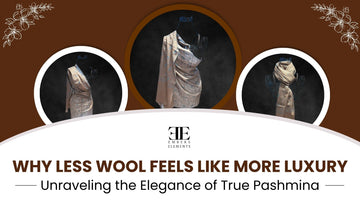When you think of luxury, chances are you imagine something rich, soft, and effortlessly beautiful — much like a handwoven certified Cashmere Pashmina shawl. But here’s the surprising twist: with true Pashmina, less wool means more luxury.
Sounds like a paradox, right? Let’s unravel the story behind it.
Today, we’ll explore why authentic Pashmina is prized not for its thickness, but for its unbelievable lightness and softness.

What Makes Pashmina So Special?
First, let's start with what Pashmina is.
Pashmina is the finest form of Cashmere wool, gathered from the soft undercoat of the rare Changthangi goats that live in the cold, high-altitude regions of Ladakh, India. These goats grow a special under-fleece to survive freezing Himalayan winters.
Each spring, the goats naturally shed this undercoat. Local herders gently comb the fleece — never shearing — ensuring the wool remains at its softest, most natural state.
This delicate wool is then hand-spun and hand-woven into breathtaking shawls. It’s a process that takes time, care, and centuries of traditional craftsmanship.

Less Wool, More Wow: The Luxury in Lightness
Here’s where the paradox comes in.
When most people think of warmth, they imagine thick, heavy fabrics. But true Pashmina works differently.
-
The fibers are incredibly fine — about 12–16 microns thick (a human hair is about 75 microns!)
-
Air gets trapped between the fibers, creating natural insulation without weight.
-
The weaving is open and breathable, giving it that magical balance of warm yet featherlight.
This is why an authentic Pashmina shawl feels almost weightless on your shoulders — yet wraps you in unbelievable warmth and softness.
In the world of luxury, it's not the heaviness that counts — it's the rarity, craftsmanship, and tactile pleasure. True elegance whispers; it doesn’t shout.

Why Certified Cashmere Matters
With so many mass-produced "Pashmina" scarves flooding the market (often made of blends or even acrylic), how can you know you’re getting the real thing?
That’s where certified Cashmere Pashmina shawls come in.
When you see the word "certified," it means:
-
The wool is pure and meets strict quality standards.
-
The weaving is traditional and hand-crafted, not machine-made.
-
The artisans are fairly compensated for their skill and heritage.
Choosing a certified Pashmina isn't just about luxury — it’s about supporting sustainable fashion, ethical production, and true craftsmanship.
How to Care for Your Pashmina Shawl
Because true Pashmina is so fine, it deserves gentle care:
-
Hand wash in cold water with a mild detergent, or better yet, dry clean.
-
Dry flat on a towel; never wring it out.
-
Store folded in a breathable cotton bag — no hanging, to prevent stretching.
Treat it like the treasure it is, and it will reward you with years (even decades) of timeless beauty.
Embrace the Lightness
In a world where louder often seems better, true luxury lives in the quiet moments — in the soft brush of Pashmina against your skin, in the careful hands that wove every fiber, and in the whispered legacy of centuries-old craftsmanship.
The Pashmina Paradox reminds us that less isn’t less. It’s more — more skill, more beauty, more meaning.
So the next time you wrap yourself in a handwoven certified Cashmere Pashmina shawl, know that you’re carrying something extraordinary: an effortless luxury born from nature, tradition, and love.





